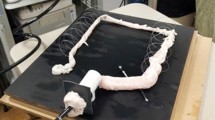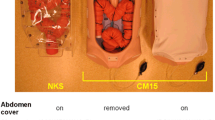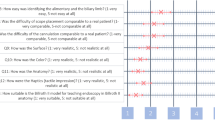Abstract
Colonoscopic examination is considered an effective examination for the detection of colorectal cancers. Additionally, early colorectal cancers can be resected using endoscopic techniques such as endoscopic mucosal resection and endoscopic submucosal dissection. However, those examinations and treatments need special techniques. Various training methods are practiced to acquire such endoscopic techniques throughout the world. In clinical cases, magnetic positioning devices help endoscopic insertion by less experienced endoscopists. There is a physical model made by polyvinyl chloride and a virtual simulator for training of colonoscopic insertion. Various techniques including a method to apply pressure to the abdomen and consideration for patient’s pain can be trained using these models. In view of extensive training of endoscopic mucosal resection and endoscopic submucosal dissection, animal models are useful and actually used. Live animal models of minipig, which entails blood flow, are ideal and used frequently, but are cumbersome to prepare. On the other hand, ex vivo animal models using intestine of porcine and bovine are convenient for preparation and less expensive. Unique ex vivo animal models with blood flow have been developed recently and techniques for hemostasis can be practiced. With respect to a method of training for colorectal endoscopic submucosal dissection, a stepwise system has been adopted throughout the world. Thus, first they observe the expert’s technique, then practice training of animal models, and finally, they perform clinical rectal cases. The system is useful for a safe and definite procedure. In this review, we reveal various training methods for colonoscopic examinations and treatments.







Similar content being viewed by others
References
International Agency for Research on Cancer. World Health Organization. Cancer Mondial. http://www-dep.iarc.fr/. Accessed 15 Jan 2013.
Kudo S, Hirota S, Nakajima T, et al. Colorectal tumours and pit pattern. J Clin Pathol. 1994;47:880–885.
Sano Y, Ikematsu H, Fu KI, et al. Meshed capillary vessels by use of narrow-band imaging for differential diagnosis of small colorectal polyps. Gastrointest Endosc. 2009;69:278–283.
Yoshida N, Naito Y, Kugai M, et al. Efficacy of magnifying endoscopy with flexible spectral imaging color enhancement in the diagnosis of colorectal tumors. J Gastroenterol. 2011;46:65–72.
Tanaka S, Haruma K, Oka S, et al. Clinicopathological features and endoscopic treatment of superficially spreading colorectal neoplasms larger than 20 mm. Gastrointest Endosc. 2001;54:62–66.
Saito Y, Fukuzawa M, Matsuda T, et al. Clinical outcome of endoscopic submucosal dissection versus endoscopic mucosal resection of large colorectal tumors as determined by curative resection. Surg Endosc. 2010;24:343–352.
Yoshida N, Naito Y, Yagi Y, et al. Importance of histological evaluation in endoscopic submucosal dissection and endoscopic mucosal resection for early colorectal cancer. World J Gastrointest Pathophysiol. 2012;3:44–59.
Yoshida N, Naito Y, Inada Y, et al. Multicenter study of endoscopic mucosal resection using 0.13% hyaluronic acid solution of colorectal polyps less than 20 mm in size. Int J Colorectal Dis. 2013;28:49–56.
Parry BR, William SM. Competency and the colonoscopist: a learning curve. Aust N Z J Surg. 1991;61:419–422.
Saunders BP, Bell GD, Williams CB, Bladen JS, Anderson AP. First clinical results with a real time, electronic imager as an aid to colonoscopy. Gut. 1995;36:913–917.
Shah SG, Brooker JC, Williams CB, Thapar C, Saunders BP. Effect of magnetic endoscope imaging on colonoscopy performance: a randomised controlled trial. Lancet. 2000;356:1718–1722.
Hill A, Horswill MS, Plooy AM, et al. Assessing the realism of colonoscopy simulation: the development of an instrument and systematic comparison of 4 simulators. Gastrointest Endosc. 2012;75:631–640.
Sedlack RE, Kolars JC. Computer simulator training enhances the competency of gastroenterology fellows at colonoscopy: results of a pilot study. Am J Gastroenterol. 2004;99:33–37.
Park J, MacRae H, Musselman LJ, et al. Randomized controlled trial of virtual reality simulator training: transfer to live patients. Am J Surg. 2007;194:205–211.
Ahlberg G, Hultcrantz R, Jaramillo E, Lindoblom A, Arvidsson D. Virtual reality colonoscopy simulation: a compulsory practice for the future colonoscopist? Endoscopy. 2005;37:1198–1204.
Cohen J, Cohen SA, Vora KC, et al. Multicenter, randomized, controlled trial of virtual-reality simulator training in acquisition of competency in colonoscopy. Gastrointest Endosc. 2006;64:361–368.
Qiao W, Bai Y, Lv R, et al. The effect of virtual endoscopy simulator training on novices: a systematic review. PLoS One. 2014;9:e89224.
Rosenburg N. Submucosal saline wheal as safety factor in fulguration or rectal and sigmoidal polyp. AMA Arch Surg. 1955;70:120–122.
Tada M, Shimada Y, Murakami F, et al. Development of the strip-off biopsy [in Japanese with English abstract]. Gastroenterol Endosc. 1984;26:833–839.
Karita M, Tada M, Okita K. The successive strip biopsy partial resection technique for large early gastric and colon cancers. Gastrointest Endosc. 1992;38:174–178.
Saito Y, Fukuzawa M, Matsuda T, et al. Clinical outcome of endoscopic submucosal dissection versus endoscopic mucosal resection of large colorectal tumors as determined by curative resection. Surg Endosc. 2010;24:343–352.
Walsh RM, Ackroyd FW, Shellito PC. Endoscopic resection of large sessile colorectal polyps. Gastrointest Endosc. 1992;38:303–309.
Tajika M, Niwa Y, Bhatia V, et al. Comparison of endoscopic submucosal dissection and endoscopic mucosal resection for large colorectal tumors. Eur J Gastroenterol Hepatol. 2011;23:1042–1049.
Iishi H, Tatsuta M, Iseki K, et al. Endoscopic piecemeal resection with submucosal saline injection of large sessile colorectal polyps. Gastrointest Endosc. 2000;51:697–700.
Kobayashi N, Yoshitake N, Hirahara Y, et al. A matched case-control study comparing endoscopic submucosal dissection and endoscopic mucosal resection for colorectal tumors. J Gastroenterol Hepatol. 2012;27:728–733.
Uraoka T, Fujii T, Saito Y, et al. Effectiveness of glycerol as a submucosal injection for EMR. Gastrointest Endosc. 2005;61:736–740.
Yoshida N, Naito Y, Kugai M, et al. Efficacy of hyaluronic acid in endoscopic mucosal resection for colorectal tumors. J Gastroenterol Hepatol. 2011;26:286–291.
Fujishiro M, Yahagi N, Kashimura K, et al. Different mixtures of sodium hyaluronate and their ability to create submucosal fluid cushions for endoscopic mucosal resection. Endoscopy. 2004;36:584–589.
Yoshida N, Naito Y, Inada Y, et al. Endoscopic mucosal resection with 0.13% hyaluronic acid solution for colorectal polyps less than 20 mm: a randomized controlled trial. J Gastroenterol Hepatol. 2012;27:1377–1383.
Gotoda T, Kondo H, Ono H, et al. A new endoscopic mucosal resection procedure using an insulation-tipped electrosurgical knife for rectal flat lesions: report of two cases. Gastrointest Endosc. 1999;50:560–563.
Tanaka S, Oka S, Kaneko I, et al. Endoscopic submucosal dissection for colorectal neoplasia: possibility of standardization. Gastrointest Endosc. 2007;66:100–107.
Saito Y, Uraoka T, Yamaguchi Y, et al. A prospective, multicenter study of 1111 colorectal endoscopic submucosal dissections (with video). Gastrointest Endosc. 2010;72:1217–1225.
Fujishiro M, Yahagi N, Kakushima N, et al. Outcomes of endoscopic submucosal dissection for colorectal epithelial neoplasms in 200 consecutive cases. Clin Gastroenterol Hepatol. 2007;5:678–683.
Yoshida N, Naito Y, Sakai K, et al. Outcome of endoscopic submucosal dissection for colorectal tumors in elderly people. Int J Colorectal Dis. 2010;25:455–461.
Yoshida N, Yagi N, Naito Y, et al. Safe procedure in endoscopic submucosal dissection for colorectal tumors focused on preventing complications. World J Gastroenterol. 2010;16:1688–1695.
Yoshida N, Wakabayashi N, Kanemasa K, et al. Endoscopic submucosal dissection for colorectal tumors: technical difficulties and rate of perforation. Endoscopy. 2009;41:758–761.
Takeuchi Y, Uedo N, Ishihara R, et al. Efficacy of an endo-knife with a water-jet function (Flushknife) for endoscopic submucosal dissection of superficial colorectal neoplasms. Am J Gastroenterol. 2010;105:314–322.
Toyonaga T, Man-I M, Morita Y, et al. The new resources of treatment for early stage colorectal tumors: EMR with small incision and simplified endoscopic submucosal dissection. Dig Endosc. 2009;21:S31–S37.
Kim ES, Cho KB, Park KS, et al. Factors predictive of perforation during endoscopic submucosal dissection for the treatment of colorectal tumors. Endoscopy. 2011;43:573–578.
Lee EJ, Lee JB, Choi YS, et al. Clinical risk factors for perforation during endoscopic submucosal dissection (ESD) for large-sized, nonpedunculated colorectal tumors. Surg Endosc. 2012;26:1587–1594.
Repici A, Conio M, De Angelis C, et al. Insulated-tip knife endoscopic mucosal resection of large colorectal polyps unsuitable for standard polypectomy. Am J Gastroenterol. 2007;102:1617–1623.
Yoshida N, Yagi N, Inada Y, et al. Possibility of ex vivo animal training model for colorectal endoscopic submucosal dissection. Int J Colorectal Dis. 2013;28:49–56.
Uraoka T, Parra-Blanco A, Yahagi N. Colorectal endoscopic submucosal dissection: is it suitable in Western countries? J Gastroenterol Hepatol. 2013;28:406–414.
Ohata K, Ito T, Chiba H, et al. Effective training system in colorectal endoscopic submucosal dissection. Dig Endosc. 2012;24:84–89.
Gotoda T, Friedland S, Hamanaka H, et al. A learning curve for advanced endoscopic resection. Gastrointest Endosc. 2005;62:866–867.
Choi IJ, Kim CG, Chang HJ, et al. The learning curve for EMR with circumferential mucosal incision in treating intramucosal gastric neoplasm. Gastrointest Endosc. 2005;62:860–865.
Hotta K, Oyama T, Shinohara T, et al. Learning curve for endoscopic submucosal dissection of large colorectal tumors. Dig Endosc. 2010;22:302–306.
Akahoshi K, Motomura Y, Kubokawa M, et al. Endoscopic submucosal dissection of a rectal carcinoid tumor using grasping type scissors forceps. World J Gastroenterol. 2009;15:2162–2165.
Honma K, Kobayashi M, Watanabe H, et al. Endoscopic submucosal dissection for colorectal neoplasia. Dig Endosc. 2010;22:307–311.
Iacopini F, Bella A, Costamagna G, et al. Stepwise training in rectal and colonic endoscopic submucosal dissection with differentiated learning curves. Gastrointest Endosc. 2012;76:1188–1196.
Probst A, Golger D, Anthuber M, Märkl B, Messmann H. Endoscopic submucosal dissection in large sessile lesions of the rectosigmoid: learning curve in a European center. Endoscopy. 2012;44:660–667.
Deprez PH, Bergman JJ, Meisner S, et al. Current practice with endoscopic submucosal dissection in Europe: position statement from a panel of experts. Endoscopy. 2010;42:853–858.
Draganov PV, Gotoda T, Chavalitdhamrong D, et al. Techniques of endoscopic submucosal dissection: application for the Western endoscopist? Gastrointest Endosc. 2013;78:677–688.
Parra-Blanco A, Arnau MR, Nicolás-Pérez D, et al. Endoscopic submucosal dissection training with pig models in a Western country. World J Gastroenterol. 2010;16:2895–2900.
Berr F, Ponchon T, Neureiter D, et al. Experimental endoscopic submucosal dissection training in a porcine model: learning experience of skilled Western endoscopists. Dig Endosc. 2011;23:281–289.
CME Asge programs Committee. Updated guidelines for live endoscopy demonstrations. Gastrointest Endosc. 2010;71:1105–1107.
Tanimoto MA, Torres-Villalobos G, Fujita R, et al. Endoscopic submucosal dissection in dogs in a World Gastroenterology Organisation training center. World J Gastroenterol. 2010;16:1759–1764.
Parra-Blanco A, Gonzalez N, Arnau MR. Ex vivo and in vivo models for endoscopic submucosal dissection training. Clin Endosc. 2012;45:350–357.
Hon SS, Ng SS, Lee JF, et al. In vitro porcine training model for colonic endoscopic submucosal dissection: an inexpensive and safe way to acquire a complex endoscopic technique. Surg Endosc. 2010;24:2439–2443.
Parra-Blanco A, Saito Y, Yahagi N, et al. Recommendations about training for colorectal endoscopic submucosal dissection in the Western world. Results of a survey to experts. Gastrointest Endosc. 2011;73:AB419–AB420.
Pham DV, Shah A, Borao FJ, et al. Endoscopic submucosal dissection training with ex vivo human gastric remnants. Surg Endosc. 2014;28:222–226.
Fujishiro M, Yahagi N, Kakushima N, et al. Successful nonsurgical management of perforation complicating endoscopic submucosal dissection of gastrointestinal epithelial neoplasms. Endoscopy. 2006;38:1001–1006.
Acknowledgments
We thank Yasuhisa Abe and Shigenori Shikata for providing ex vivo animal models. We also thank Ryohei Hirose, Kiyoshi Ogiso, Yasutaka Morimoto, Ken Inoue, Daisuke Hasegawa, Naoki Wakabayashi and all other members at the Department of Molecular Gastroenterology and Hepatology in Kyoto Prefectural University of Medicine for several studies related with this review.
Conflict of interest
Yoshito Itoh is affiliated with AstraZeneca Co., Ltd., Eisai Co., Ltd., Otsuka Pharmaceutical Co., Ltd., MSD K.K., Dainippon Sumitomo Pharma Co., Ltd., Chugai Pharmaceutical Co., Ltd., FUJIFILM Medical Co., Ltd. and Merck Serono Co., Ltd. Yoshito Itoh received research grants from MSD K.K. and Bristol-Myers K.K. Yuji Naito received research grants from Otsuka Pharmaceutical Co., Ltd. and Takeda Pharmaceutical Co., Ltd. The other authors have no conflicts of interest to declare. Besides, these things described above, there are no financial supports or relationships that may pose conflict of interest in our manuscript.
Author information
Authors and Affiliations
Corresponding author
Rights and permissions
About this article
Cite this article
Yoshida, N., Fernandopulle, N., Inada, Y. et al. Training Methods and Models for Colonoscopic Insertion, Endoscopic Mucosal Resection, and Endoscopic Submucosal Dissection. Dig Dis Sci 59, 2081–2090 (2014). https://doi.org/10.1007/s10620-014-3308-y
Received:
Accepted:
Published:
Issue Date:
DOI: https://doi.org/10.1007/s10620-014-3308-y




